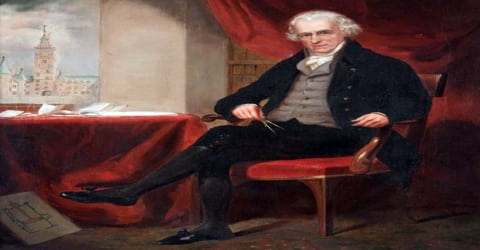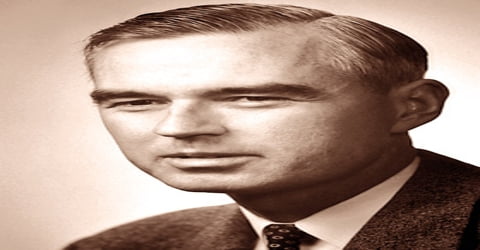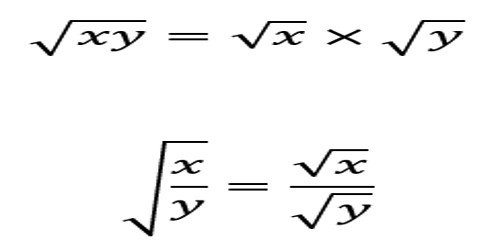Biography of James Watt
James Watt- Scottish Inventor, Mechanical Engineer, and Chemist.
Name: James Watt
Date of Birth: 19 January 1736
Place of Birth: Greenock, Renfrewshire, Scotland, United Kingdom
Date of Death: 25 August 1819 (aged 83)
Place of Death: Handsworth, Birmingham, England, United Kingdom
Early Life

James Watt was a great Scottish engineer of the 18th century (born January 19, 1736, Greenock, Renfrewshire, Scotland—died August 25, 1819, Heathfield Hall, near Birmingham, Warwick, England). He is famous for developing a separate condensing chamber for the steam engine. This invention greatly improved the efficiency of the steam engine and played a considerable role in advancing the role of steam engines in the Industrial Revolution.
He did not actually invent the steam engine. Instead, he greatly improved it. A man named Thomas Savery invented the first primitive steam engine in 1698. A man named Newcomen started making steam engines to pump water from mines in 1712. However, Watt is famous for inventing an improved version in 1769.
While working as an instrument maker at the University of Glasgow, Watt became interested in the technology of steam engines. He realized that contemporary engine designs wasted a great deal of energy by repeatedly cooling and reheating the cylinder. Watt introduced a design enhancement, the separate condenser, which avoided this waste of energy and radically improved the power, efficiency, and cost-effectiveness of steam engines. Eventually, he adapted his engine to produce rotary motion, greatly broadening its use beyond pumping water.
In 1766 Watt got a job as a land surveyor marking out land for canals. Then in 1774, James Watt moved to Birmingham. In 1775 he went into partnership with Matthew Boulton and began making steam engines. His steam engines were used for pumping water out of mines and gradually he became a wealthy man. In his retirement, Watt continued to develop new inventions though none was as significant as his steam engine work.
Watt also made other important discoveries and inventions. These included a copying machine and an improved production method for chlorine, a bleaching agent.
After his fortune enabled him to retire, he pursued a wide variety of interests from improving oil lamps to measuring distances with a telescope.
Childhood, Family and Educational Life
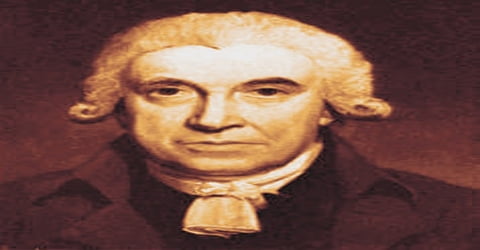
James Watt was born in Greenock on 19 January 1736 in Greenock, Renfrewshire, a seaport on the Firth of Clyde. His father was a shipwright, ship owner, and contractor, and served as the town’s chief Baillie, while his mother, Agnes Muirhead, came from a distinguished family and was well educated. Both were Presbyterians and strong Covenanters. Watt’s grandfather, Thomas Watt, was a mathematics teacher and Baillie to the Baron of Cartsburn. Despite being raised by religious parents, he later became a deist.
Watt did not attend school regularly; initially, he was mostly schooled at home by his mother. As a boy, Watt went to the local grammar school where he learned the classics and mathematics. However, Watt also liked making models.
The source for an important part of his education was his father’s workshops, where, with his own tools, bench, and forge, he made models (e.g., of cranes and barrel organs) and grew familiar with ships’ instruments.
Deciding at age 17 to be a mathematical-instrument maker, Watt first went to Glasgow, where one of his mother’s relatives taught at the university, and then, in 1755, to London, where he found a master to train him. Although his health broke down within a year, he had learned enough in that time “to work as well as most journeymen.” Returning to Glasgow, he opened a shop in 1757 at the university and made mathematical instruments (e.g., quadrants, compasses, scales). He met many scientists and became a friend of British chemist and physicist Joseph Black, who developed the concept of latent heat.
Personal Life
In 1764 James Watt married his cousin Margaret (Peggy) Miller, who, before she died nine years later, bore him six children.
In 1777 he has married again, to Ann MacGregor, daughter of a Glasgow dye-maker, with whom he had two children: Gregory (1777–1804), who became a geologist and mineralogist, and Janet (1779–1794). Ann died in 1832. Between 1777 and 1790 he lived in Regent Place, Birmingham.
Career and Works
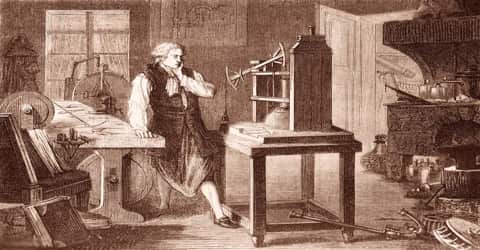
Around 1764, Watt was given a Newcomen steam engine to repair. He realized it was very inefficient because energy was repeatedly being used to heat the cylinder. He decided to try and invent a more efficient alternative and he worked on a model which caused steam to condense inside a separate chamber apart from the piston. In a Newcomen, engine steam is admitted into a cylinder then condensed back into the water. In 1765 Watt realized it would be more efficient to condense the steam in another chamber separate from the cylinder. However, it was not until 1769 that Watt patented his new idea, the separate condenser.
Though Watt was not adept at business, he was able to form a successful partnership with Matthew Boulton. Boulton & Watt became a successful company leasing the design and later producing these new steam engines for a variety of purposes from mining (especially Cornish tin mines) to cloth and wool manufacture. Over the next six years, he made a number of other improvements to the steam engine and the business thrived as orders flooded in.
In 1759 Watt’s friend, John Robison called his attention to the use of steam as a source of motive power. The design of the Newcomen engine, in use for almost 50 years for pumping water from mines, had hardly changed from its first implementation. Watt began to experiment with steam, though he had never seen an operating steam engine. He tried constructing a model; it failed to work satisfactorily, but he continued his experiments and began to read everything he could about the subject. He came to realize the importance of latent heat—the thermal energy released or absorbed during a constant-temperature process—in understanding the engine, which, unknown to Watt, his friend Joseph Black had previously discovered some years before. Understanding of the steam engine was in a very primitive state, for the science of thermodynamics would not be formalized for nearly another 100 years.
Shortly afterward he met British physician, chemist, and inventor John Roebuck, the founder of the Carron Works, who urged him to make an engine. He entered into the partnership with him in 1768, after having made a small test engine with the help of loans from Joseph Black. The following year Watt took out the famous patent for “A New Invented Method of Lessening the Consumption of Steam and Fuel in Fire Engines.”
Meanwhile, Watt in 1766 became a land surveyor; for the next eight years, he was continuously busy marking out routes for canals in Scotland, work that prevented his making further progress with the steam engine. After Roebuck went bankrupt in 1772, English manufacturer and engineer Matthew Boulton, the manufacturer of the Soho Works in Birmingham, took over a share in Watt’s patent. Bored with surveying and with Scotland, Watt immigrated to Birmingham in 1774. After Watt’s patent was extended by an act of Parliament, he and Boulton in 1775 began a partnership that lasted 25 years.
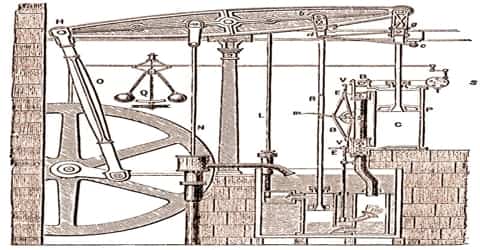
In 1776, the first engines were installed and working in commercial enterprises. These first engines were used to power pumps and produced only reciprocating motion to move the pump rods at the bottom of the shaft. The design was commercially successful, and for the next five years, Watt was very busy installing more engines, mostly in Cornwall for pumping water out of mines.
The erection of the engine and its shakedown was supervised by Watt, at first, and then by men in the firm’s employ. These were large machines. The first, for example, had a cylinder with a diameter of some 50 inches and an overall height of about 24 feet and required the construction of a dedicated building to house it. Boulton and Watt charged an annual payment, equal to one-third of the value of the coal saved in comparison to a Newcomen engine performing the same work.
By 1780 the Industrial Revolution was beginning to transform life in Britain and Watt adapted his steam engine to provide a rotary motion so they could be used to power machines in the new factories. In 1781 he made the sun and planet gear to do this. In 1785 steam engines were used to power machines in cotton mills for the first time. Meanwhile in 1782 Watt invented another major improvement the double-acting steam engine. In 1788 Watt invented the fly ball governor to regulate the speed of steam engines and in 1790 he invented a pressure gauge.
By 1790 Watt was a wealthy man, having received £76,000 in royalties on his patents in 11 years. The steam engine did not absorb all his attention, however. He was a member of the Lunar Society in Birmingham, a group of writers and scientists who wished to advance the sciences and the arts.
By 1792 he had started making engines of his own design, but which contained a separate condenser, and so infringed Watt’s patents. Two brothers, Jabez Carter Hornblower and Jonathan Hornblower Jnr also started to build engines about the same time. Others began to modify Newcomen engines by adding a condenser, and the mine owners in Cornwall became convinced that Watt’s patent could not be enforced. They started to withhold payments due to Boulton and Watt, which by 1795 had fallen. Of the total £21,000 (equivalent to £1,990,000 as of 2016) owed, only £2,500 had been received. Watt was forced to go to court to enforce his claims.
Before 1780 there was no good method for making copies of letters or drawings. The only method sometimes used as a mechanical one using linked multiple pens. Watt at first experimented with improving this method but soon gave up on this approach because it was so cumbersome. He started to develop the process in 1779 and made many experiments to formulate the ink, select the thin paper, to devise a method for wetting the special thin paper, and to make a press suitable for applying the correct pressure to effect the transfer. All of these required much experimentation, but he soon had enough success to patent the process a year later.
From an early age, Watt was very interested in chemistry. He was improved production method for chlorine, a bleaching agent. After his fortune enabled him to retire, he pursued a wide variety of interests from improving oil lamps to measuring distances with a telescope.
Watt was the sole inventor listed on his six patents:
- Patent 913 A method of lessening the consumption of steam in the steam engines-the separate condenser. The specification was accepted on 5 January 1769; enrolled on 29 April 1769, and extended to June 1800 by an act of Parliament in 1775.
- Patent 1,244 A new method of copying letters; The specification was accepted on 14 February 1780 and enrolled on 31 May 1780.
- Patent 1,306 New methods to produce a continued rotation motion – sun and planet. The specification was accepted on 25 October 1781 and enrolled on 23 February 1782.
- Patent 1,321 New improvements upon steam engines – expansive and double acting. The specification was accepted on 14 March 1782 and enrolled on 4 July 1782.
- Patent 1,432 New improvements upon steam engines – three bar motion and steam carriage. The specification was accepted on 28 April 1782 and enrolled on 25 August 1782.
- Patent 1,485 Newly improved methods of constructing furnaces. The specification was accepted on 14 June 1785 and enrolled on 9 July 1785.
The development of an efficient steam engine transformed industry and society. It helped Great Britain to become the world’s first industrialized society leading to an unprecedented pace of economic growth.
Death and Legacy
James Watt died on 25 August 1819 at his home “Heathfield” in Handsworth, Staffordshire (now part of Birmingham) at the age of 83. He was buried on 2 September in the graveyard of St Mary’s Church, Handsworth. The church has since been extended and his grave is now inside the church.
The Watt engine was a defining development of the Industrial Revolution because of its rapid incorporation into many industries. Because of Watt’s contributions to science and industry, the watt, the unit of power in the International System of Units (SI) equal to one joule of work performed per second (or 1/746 horsepower), was named for him. Some scientists argue that the design of the parallel motion (or double-acting engine) in 1784 should serve as the starting point of the Anthropocene Epoch—the unofficial interval of geologic time in which human activity began to substantially alter Earth’s surface, atmosphere, and oceans.
The huge painting James Watt contemplating the steam engine by James Eckford Lauder is now owned by the National Gallery of Scotland. There is a statue of James Watt in Piccadilly Gardens, Manchester and City Square, Leeds.
A colossal statue of Watt by Chantrey was placed in Westminster Abbey and later was moved to St. Paul’s Cathedral.
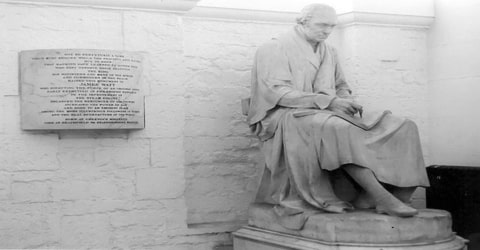
Honors
In 1785 James Watt was elected a fellow of the Royal Society. He was elected as a member of the Batavian Society for Experimental Philosophy, of Rotterdam in 1787. In 1789 he was elected to the elite group, the Smeatonian Society of Civil Engineers. In 1806 he was conferred the honorary Doctor of Laws by the University of Glasgow. The French Academy elected him a Corresponding Member and he was made a Foreign Associate in 1814.
The watt is named after James Watt for his contributions to the development of the steam engine, and was adopted by the Second Congress of the British Association for the Advancement of Science in 1889 and by the 11th General Conference on Weights and Measures in 1960 as the unit of power incorporated in the International System of Units (or “SI”).
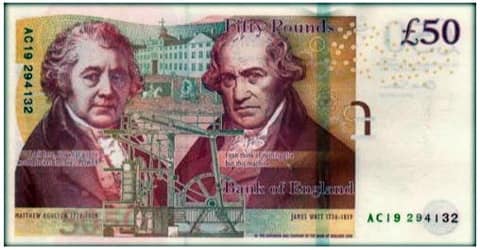
On 29 May 2009, the Bank of England announced that Boulton and Watt would appear on a new £50 note. Quotes attributed to each of the men are inscribed on the note: “I sell here, sir, what all the world desires to have—POWER” (Boulton) and “I can think of nothing else but this machine” (Watt). The inclusion of Watt is the second time that a Scot has featured on a Bank of England note (the first was Adam Smith on the 2007 issue £20 note).
In September 2011 it was announced that the notes would enter circulation on 2 November.
In 2011 he was one of seven inaugural inductees to the Scottish Engineering Hall of Fame.
Information Source:
